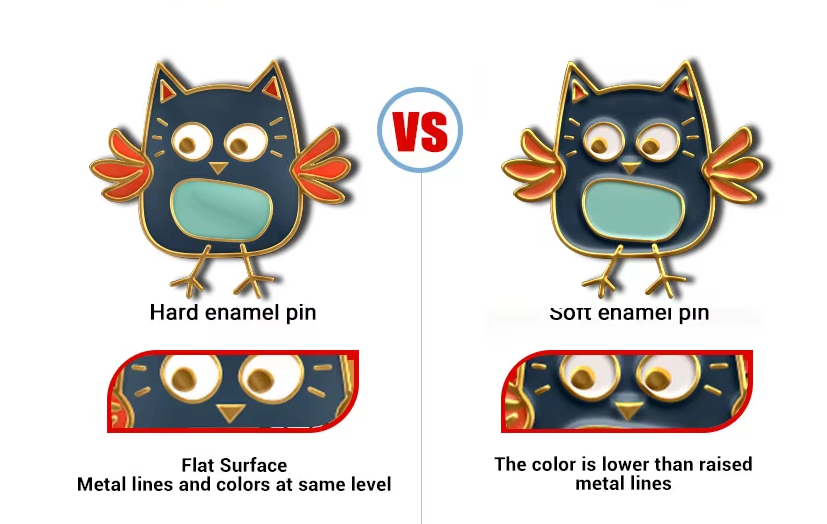
Hard Enamel vs. Soft Enamel
Share

Hard Enamel vs. Soft Enamel
Enamel is a versatile material widely used in jewelry, decorative arts, badges, and industrial applications. Two prominent techniques—**hard enamel** and **soft enamel**—are often compared due to their distinct properties and uses. While both involve fusing powdered glass to metal substrates, their manufacturing processes, aesthetics, durability, and applications differ significantly. Below is a detailed analysis of these two enamel types, followed by a summary table for quick reference.
Definition and Manufacturing Process
Hard Enamel (Cloisonné or Vitreous Enamel)
Hard enamel, also known as "cloisonné* or *vitreous enamel", involves a high-temperature firing process (typically between 750°C and 850°C). The enamel powder is applied to a metal base (usually copper, silver, or gold) and melted until it forms a smooth, glass-like surface. Multiple layers may be fired to achieve depth and uniformity. After cooling, the piece is polished to remove excess material, resulting in a flat, glossy finish.
Soft Enamel
Soft enamel, sometimes called "epoxy enamel" or ‘’filled enamel“”, uses a similar application process but requires lower firing temperatures (around 300°C–500°C). The enamel powder is melted just enough to adhere to the metal but retains a slightly raised, textured surface. A protective epoxy resin is often applied post-firing to enhance durability and shine. The final product has visible recessed areas between color sections.
Physical and Aesthetic Differences
| Feature | Hard enamel | Soft enamel |
| Surface Texture | Smooth, flat, and glossy | Textured, with raised metal separations |
| Color Depth | Rich, vibrant colors with a glass-like finish | |Bright colors but less depth due to resin coating |
| Dimensionality | Single-level surface | Multi-level, tactile design |
| Edge Definition | Crisp, seamless edges | Defined metal borders between colors |
Durability and Maintenance
Hard Enamel
1,Durability: Extremely resistant to scratches, UV rays, and chemicals due to the hardened glass layer. Suitable for long-term use.
2,Maintenance: Easy to clean with mild soap and water. Does not require frequent recoating.
3,Lifespan: Decades if properly cared for; often used in heirloom-quality items.
Soft Enamel**
1,Durability: Prone to scratches and fading over time. The epoxy coating provides moderate protection but is less robust than glass enamel.
2,Maintenance: Requires gentle cleaning to avoid damaging the resin. May need periodic touch-ups.
3,Lifespan: 5–10 years, depending on usage and exposure.
Cost and Production Complexity
| Feature | Hard enamel | Soft enamel |
| Production Time | Longer due to multiple firings and polishing(15-20days) | Faster; single firing and epoxy application(7-14days) |
| Labor Intensity | High (skilled artisans required) | Moderate (suitable for mass production) |
| Cost | Higher (premium materials and labor) | Lower (economical for large batches) |
Common Applications
Hard Enamel
- Luxury jewelry (e.g., brooches, pendants)
- High-end badges, military insignia, and awards
- Architectural panels and signage
- Vintage watches and decorative art
Soft Enamel
- Promotional products (e.g., pins, keychains)
- Corporate logos and event merchandise
- Custom lapel pins and souvenir items
- Electronics (decorative trim on devices)
Advantages and Disadvantages
| Aspect | Hard Enamel | Soft Enamel |
| Pros | Timeless elegance Extreme durability Scratch-resistant |
Affordable Faster production Tactile appeal |
| Cons |
Expensive Limited design flexibility |
Less durable Prone to fading |
Summary Table: Hard Enamel vs. Soft Enamel
| Criterria | Hard enamel | Soft enamel |
| Firing Temperature | 750°C–850°C | 300°C–500°C |
| Surface Finish | Smooth, flat, glass-like | Textured, recessed areas |
| Color Application | Multiple layers for depth | Single layer with epoxy coating |
| Durability | Highly scratch-resistant | Moderate, epoxy-dependent |
| Cost | High | Low to moderate |
| Production Time | 3 Weeks (due to polishing) | 7-14days |
| Ideal For | Heirlooms, luxury items | Promotional goods, casual accessories |